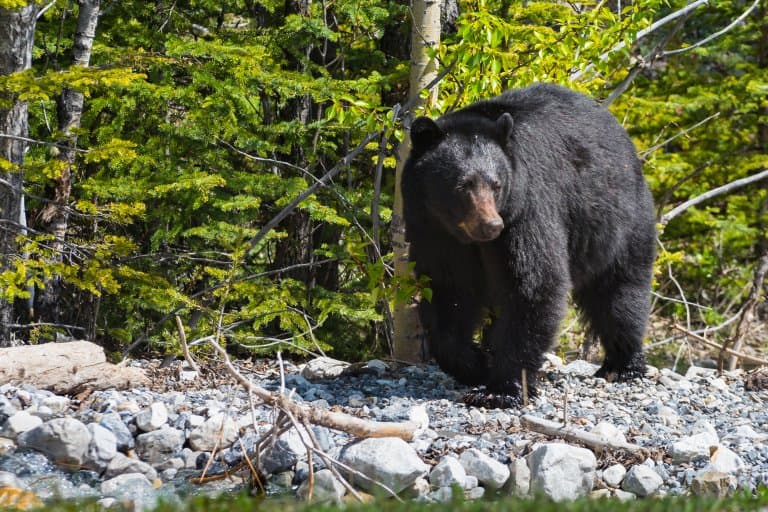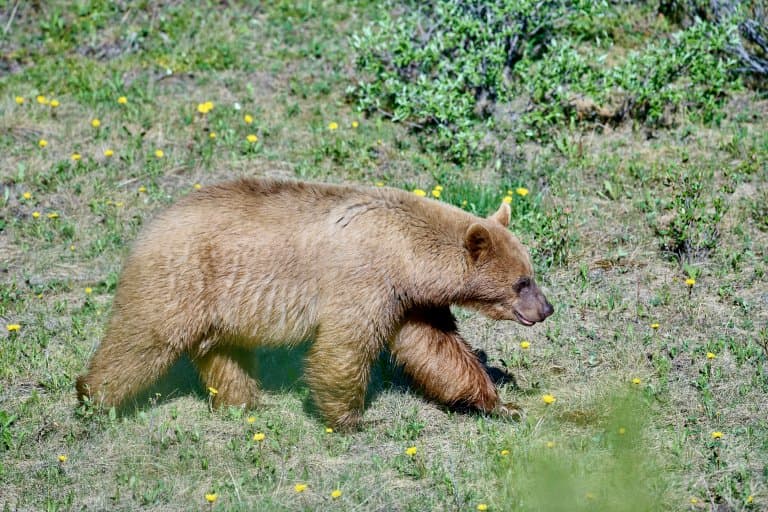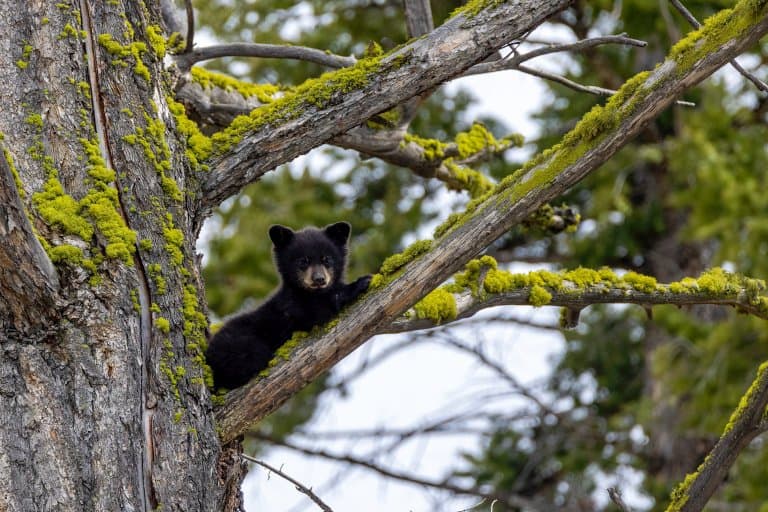American Black Bear Profile
The American black bear, more commonly known simply as the black bear, is the smallest of the 3 bear species found in America. The brown or grizzly bear and the polar bear are larger in size, however the black bear is still a huge mammal.
They can measure up to 2 metres in length and males can weigh over 400kg. When standing on their hind legs, they can reach a height of around 7 feet, although females are usually smaller and shorter than males.
Black bears can be distinguished from brown bears by their smaller size, longer ears and lack of a shoulder hump. Black bears also have shorter, more curved claws and are generally more timid animals. Typically they are black in color but depending on their location, their fur can be dark or light brown.
Black bears are found throughout North America but are more abundant in the northern states. Unlike brown bears, they prefer more densely forested habitats and rarely venture into open areas for long periods of time.

American Black Bear Facts Overview
| Habitat: | Prefer forested areas |
| Location: | North America |
| Lifespan: | 18 years in the wild on average |
| Size: | Up to 2m in length |
| Weight: | 40 – 250 kg |
| Color: | Black to brown fur with lighter coloured muzzle. A relatively short and stocky bear. Smallest of the 3 American bear species |
| Diet: | Omnivorous, eating a variety of plant and animal matter |
| Predators: | Adults have no natural predators. Cubs are sometimes killed by mountain lions, wolves and other bears |
| Top Speed: | Around 50 kph (31 mph) |
| No. of Species: |
1 |
| Conservation Status: |
Least Concern |
Black bears have a very versatile diet and this allows them to occupy many different types of forest habitat. These bears usually avoid food competition from the larger brown bears and although their ranges can overlap, black bears will usually move to a different area if brown bears are present.
In their natural habitat, black bears are typically active at dawn and dusk and spend the time in between resting in thick undergrowth in the forest. The diet of a black bear is very dependent on the habitat type that they occupy and the seasons of the year.
Black bears mostly feed on fruit, nuts, plants and honey but will also eat young mammals such as deer fawns as well as feeding on carrion. They will also readily eat insects such as ants and bees when they are swarming and occasionally catch fish when the opportunity arises.
The American black bear has a reputation for being a timid and shy species, preferring to avoid humans where possible. As they are such opportunistic feeders however, black bears can become a nuisance where human rubbish is left unprotected, as leftover food makes for a very easy meal.
In the wild, black bears are mostly solitary animals, spending their time eating and resting and avoiding other bears. At times when there is a significant number of fruiting plants, black bears will occasionally congregate in large numbers to feed, usually keeping their distance and allowing the largest bear their choice of feeding spot. 1
Like the other bear species in their range, black bears hibernate during the winter when food is scarce and temperatures drop dramatically.
Before this time, black bears furiously feed to gain enough fatty deposits to see them through the winter. While in their den, they do not fully hibernate but lower their body temperature for several days and sleep before waking up, feeding on stored food and urinating and defecating. They then return back to their resting state and repeat this cycle until spring arrives. 2
The black bear population is estimated to be double that of all other bear species combined and it’s widely distributed, and is therefore classified as a species of least concern by the IUCN.
Interesting American Black Bear Facts
1. They are not always black in colour
Some black bears can be a very light brown (or cinnamon) color and very rarely, completely white. 3

2. Black bears are shy and timid
Black bears will usually run away or climb up a tree rather than confront humans.
This is mostly true but some individual black bears can be very aggressive, especially when threatened.
They are however much less likely to attack compared to the brown or grizzly bears, which tend to be less weary and less approachable.
Both these species, as well as the polar bear, will usually move on when left alone and black bears especially tend to flee when confronted by people. 4
3. They can eat over 10,000 berries in a day
When food is abundant, black bears will eat as much food as they possibly can, sometimes over 8kg of fruit and berries in a day.
When berries and fruits are abundant, black bears will move to these areas and feed almost exclusively on these.
They have an excellent sense of smell and this helps them locate ripping berries, nuts and fruits as well as bee hives, where they feed on the honey and bee larvae. 5
4. Black bears are skilled climbers
Black bears are excellent climbers and can easily access nuts and fruits before they fall to the ground.
They have sharp, curved claws and this not only helps them when climbing but also makes ripping into trees logs or upturning boulders when searching for insects much easier.
As well as being expert climbers, black bears are great swimmers and will cross fast flowing rivers to reach food on the other side. 6

5. They are incredibly strong animals
Black bears are up to 5 times stronger than the average human being.
6. American black bears are highly dexterous
They are capable of opening screw-top jars and manipulating door latches.
7. Their diet is predominantly vegetarian
Although they do eat meat, almost 70% of their diet is made up of plant matter.
8. Their sense of smell is 7 times more sensitive than a domestic dog
While American black bears have extremely sensitive noses, their eyesight and hearing is more comparable to that of a human.

9. Black bears are fast runners
Sprinting at around 40-50km/h, black bears can easily outrun humans. 7
10 They are mostly quiet animals
Although they tongue-click and grunt to communicate with one another, black bears do not growl or roar.
11. They den in spots that are well hidden
Black bear dens are usually made in caves, under tree roots or are dug into hillsides.
12. Females usually give birth during the hibernation period
During the breeding season, a male and female will remain together until just before the cubs are born. Females usually give birth in their den while in torpor; a similar state to hibernation. The cubs will then feed off their mother’s milk while she hibernates until spring arrives.
Usually two cubs are born and they leave the den for the first time when their mother comes out of hibernation. Female black bears teach their cubs how to find food and survive in the wild until the cubs are around 17 months old and become fully independent.
The father of the cubs does not actively help in raising his offspring but does protect the territory from other males, who may attack the cubs.
13. Black bear cubs are playful animals
Cubs will regularly wrestle and play with each other as well as their mother. This helps them develop essential skills to survive in the wild.

14. Black bears are very intelligent
Black bears can memorise their whole territory, they can make scratching sticks out of twigs and can easily break into locked food storage containers. 8
15. There are black bear hybrids
American black bears can reproduce with other bear species and produce hybrid offspring.
Black bear and grizzly bear hybrids have been reported in the wild.
16. They are a key contributer to the ecosystem
Black bears are important contributors to the ecosystems in which they inhabit. Due to their large size they create micro-ecosystems where they leave deep footprints or break small trees and plants.
They are also key in controlling insect populations as well as important seed disbursers, encouraging new plant growth wherever the seeds in their stools germinate.
Black bears also have very large home ranges which means they can increase plant diversity by travelling long distances and disbursing seeds which otherwise may not have reached or germinated in that area.
American Black Bear Fact-File Summary
Scientific Classification
| Kingdom: | Animalia |
| Phylum: | Chordata |
| Class: | Mammalia |
| Order: | Carnivora |
| Family: | Ursidae |
| Genus: | Ursus |
| Species Name: |
Ursus Americanus |
Fact Sources & References
- “Ursus americanus-American black bear”, Animal Diversity.
- “American Black Bear”, World Land Trust.
- John P. Rafferty. (2023), “Black Bear”, Britannica.
- Lynn L. Rogers (2020), “Behavior in Free-Living American Black Bear Dens: Parturition, Maternal Care, and Cub Behavior”, NIH.
- Sarah McPherson, “Black bear guide: how to identify, where to find them and what to do if you encounter one”, Discover Wildlife.
- “American Black Bear”, Bear Biology.
- “American Black Bear”, National Geographic.
- Mark Hebblewhite (2003), “Black bear (Ursus americanus) survival and demography in the Bow Valley of Banff National Park, Alberta”, Science Direct.
